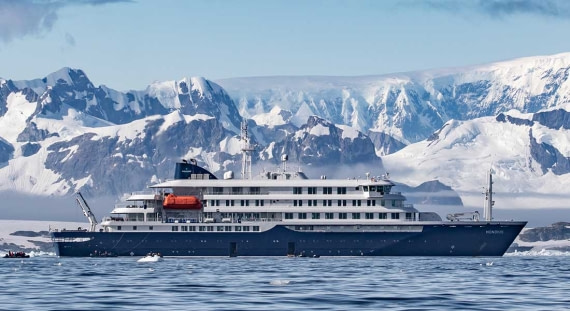| Datum: |
29.06.2024 |
| Position: |
79° 34.9' N 18° 36.3' E |
| Wind: |
SE4 |
| Wetter: |
Klarer Himmel |
| Lufttemperatur: |
+4 |
Heute Morgen sind wir früh aufgewacht, weil wir uns auf den bevorstehenden Tag gefreut haben. Bevor die Aktivitäten begannen, besuchten wir alle das Restaurant für ein herzhaftes Frühstück. Faksevågen, wird der Landeplatz sein. Lomfjord ist eine Seitenbucht im nördlichen Teil der Hinlopenstraße. Es ist nicht der größte Fjord der Welt, aber er hat eine schöne Seitenbucht an seiner Westseite, die Faksevågen (Faksebucht) heißt. Im Gegensatz zu den meisten anderen Gebieten um die Hinlopenstraße gibt es in Faksevågen grüne Tundraflächen.
Einige von uns beschlossen, ein paar Kalorien zu verbrennen und nutzten die Gelegenheit zu einem langen Spaziergang. Der Berg Faksefjellet ist mit seinen 360 Metern Höhe zwar nicht der Mount Everest, aber die Aussicht von der Spitze, die von einem großen Findling geziert wird, ist dennoch atemberaubend. Die anderen Gruppen entschieden sich für einen Spaziergang an den Hängen und am Strand. Fast am Ende der Aktion ließ ein Alarm über die Funkgeräte unsere Herzen ein wenig hüpfen, ein Eisbär schwamm im Wasser. Ruhig und mit großer Professionalität führten die Bergführer die Evakuierung in nur wenigen Minuten durch, sobald die Wanderer sicher vom Gipfel des Bergrückens zurückgeführt worden waren. Nach diesem aufregenden Vormittag hatten wir die Gelegenheit, den Bären aus der Sicherheit unseres schönen Hondius zu beobachten.
Ehe wir uns versahen, war es Zeit für das Mittagessen. Wir genossen ein köstliches Buffet, bevor wir zu unserer zweiten Aktivität des Tages aufbrachen. Wir freuten uns auf eine Zodiacfahrt zum berühmten Alkefjellet, dem "Berg der Trottellummen". Dieser beliebte arktische Ort ist die berühmteste Klippe des Svalbard-Archipels.
Der Alkefjellet ist ein wichtiger Vogelfelsen, auf dem rund 60.000 Paare brütender Trottellummen sowie eine kleinere Anzahl von Eismöwen und Dreizehenmöwen leben. Die Klippen sind hoch und steil und an manchen Stellen etwa 100 Meter hoch, einige von ihnen sind freistehende Türme, andere sind Teil des Hauptfelsens. Alle sind beeindruckende Beispiele für Dolerit-Intrusionen aus dem Jura oder der späten Kreidezeit.
Wir hatten die Gelegenheit, das Schmelzwasser von Gletschern zu beobachten, das kleine Wasserfälle bildete, die sich in langen, klaren Bächen die Felsen hinunter ergossen. Die Trottellummen flogen über unsere Köpfe hinweg, eine sicherlich atemberaubende Szenerie. Als wir uns dem Ende der Klippe näherten, bahnte sich ein Polarfuchs seinen Weg die unteren Hänge hinunter, und wir hatten die Gelegenheit, einen Blick darauf zu werfen, wie sehr sie ständig für ihre Nahrung arbeiten. Lächelnde Gesichter in allen unseren Zodiacs zeigten, wie erfreulich und erstaunlich unser Tag bisher gewesen war.
Wir kehrten zum Schiff zurück, um uns aufzuwärmen, und hatten die Dayli-Rekapitulation, Jerry erklärte uns die Aktivitäten des Tages und des nächsten Tages. Ting lehrte uns etwas über Flechten und Meike alles über Trottellummen.
Zum Abschluss eines wunderbaren Tages ging unser Expeditionsteam in Wahlbergøya an Land und richtete den Platz ein, an dem wir an Land gehen konnten. Wahlbergøya ist die größte Insel des Vaigattøyane-Archipels, einer Inselgruppe in der Hinlopenstraße. Die fast dreieckige Insel ist von ihrem nordwestlichen Kap Ryggneset bis zu ihrem südöstlichen Kap Jåderinneset etwa 13 km lang.
Wir begannen gerade, die Zodiacs zu beladen, als über Funk der Anruf kam, dass der zweite Eisbär des Tages in der Gegend sei. Wir machten stattdessen eine Zodiacfahrt und konnten eine wunderschöne Gruppe von Walrossen aus nächster Nähe beobachten. Mit ihren voluminösen Körpern und langen Stoßzähnen gab uns der Ausflug die Gelegenheit, unsere Speicherkarten mit Hunderten von Bildern zu füllen.
Der Tag war zu Ende, aber wir blieben noch stundenlang in der Lounge mit dem Expeditionsteam. Es war ein so unglaublicher Tag, dass es fast unmöglich war, zur Ruhe zu gehen, weil wir Geschichten und Bilder austauschen mussten.
TRAK Kajak-Programm: Faksevågen (pm)
Ein weiterer Tag mit leichtem Wind und ruhigem Wasser in Faksevågen. Wir verließen das Schiff um genau 08.01 Uhr, zu einer Zeit, als die meisten Leute gerade ihr Frühstück beendeten. Wir fuhren mit dem Zodiac zum nordwestlichen Punkt am Fjordeingang und stiegen schnell in unsere Kajaks. Dann fuhren wir mit einer leichten Brise nach Westen, die uns vorwärts trieb. Kelly nutzte die guten Bedingungen, um uns einige Techniken für das Wenden der Kajaks beizubringen und dabei die Kombination von Kanten- und Kehrschlägen zu betrachten. Maryse ging an einer Stelle etwas zu weit und kippte um, aber sie blieb in ihrem Kajak und mit der Unterstützung des Bugs von Frans Kajak und Kelly, der sie aufrichtete, konnte sie ein vollständiges Schwimmen vermeiden!
Nachdem wir zur Küstenebene am Kopf des Fjords gepaddelt waren, kamen wir auf der anderen Seite zurück und kurz bevor wir uns auf den Weg machten, ertönte der Ruf: "Eisbär!". Ja, ein Eisbär schwamm in etwa 500 m Entfernung quer über unseren Weg und steuerte auf das gegenüberliegende Ufer zu. Die scharfen Augen von Maryse entdeckten seinen cremegelben Kopf über den Wellen! Wie aufregend. Wir setzten uns sofort in Bewegung, und es dauerte keine zehn Minuten, bis wir alle sicher an Bord des Zodiacs und des Kajaks waren - ein Verdienst der ruhigen Haltung und des Geschicks von uns allen. Zurück auf dem Schiff wurden wir ausgeladen und unser Zodiac, das von Kaitlyn gesteuert wurde, machte sich auf den Weg zum Ufer, um bei der Evakuierung der Landung zu helfen.
































